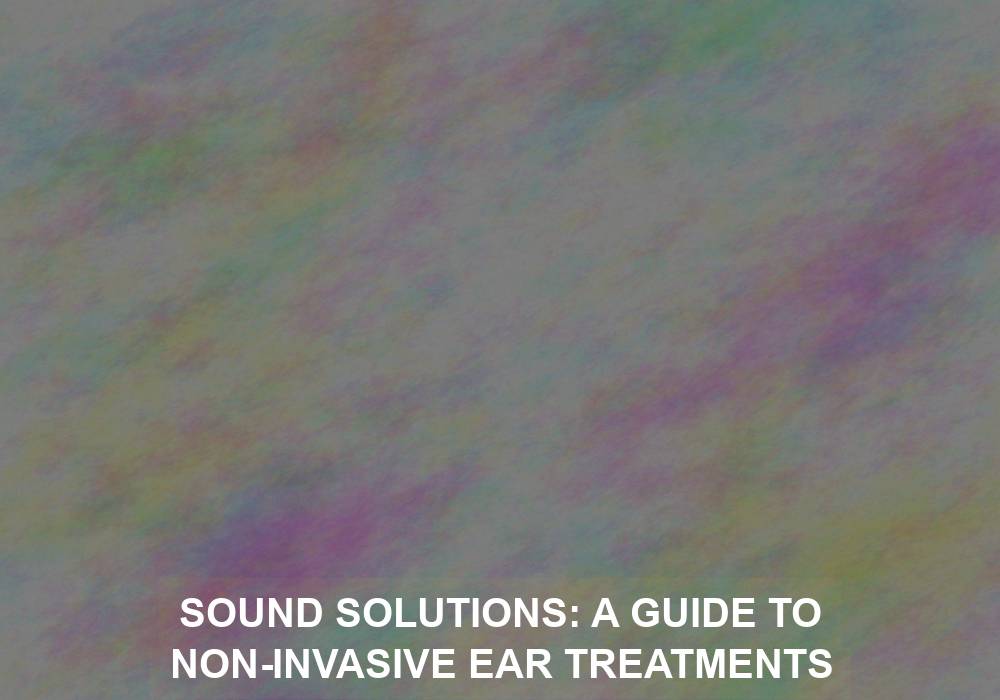Our ears play a crucial role in our sensory system, allowing us to perceive and enjoy the sounds around us. However, various factors can lead to ear-related problems and discomfort. Thankfully, there are non-invasive treatments available that can provide relief and improve overall ear health. In this comprehensive guide, we will explore different non-invasive ear treatments and shed light on their benefits and usage.
Understanding Non-Invasive Ear Treatments
Non-invasive ear treatments refer to therapeutic techniques that do not require surgical intervention or invasive procedures. These treatments aim to address common ear problems such as hearing loss, tinnitus, earwax buildup, and ear infections, among others. By utilizing non-invasive approaches, individuals can find relief without the need for complex surgeries or prolonged recovery periods.
Non-invasive ear treatments offer several advantages over invasive procedures. They carry a lower risk of complications, making them a safer option for individuals with underlying health conditions or those who prefer to avoid surgery. Additionally, the recovery period for non-invasive ear treatments is typically shorter, allowing individuals to resume their daily activities sooner. This is particularly beneficial for individuals with busy schedules or those who cannot afford extensive downtime.
Types of Non-Invasive Ear Treatments
-
Hearing Aids: For individuals experiencing hearing loss, hearing aids offer a non-invasive solution. These small electronic devices amplify sound, helping those with hearing impairments to hear more clearly. Modern hearing aids come in various styles and are customized to meet individual needs, ensuring a comfortable fit and improved sound quality.
-
Sound Therapy: Tinnitus, commonly known as ringing in the ears, can be managed through sound therapy. This treatment involves using external noises, such as white noise, to mask or distract from the perception of tinnitus. Sound therapy can provide relief and reduce the impact of tinnitus on daily life.
-
Earwax Removal: Excessive earwax buildup can cause discomfort and even temporary hearing loss. Non-invasive techniques for earwax removal include irrigation with warm water or using specialized tools like ear curettes or suction devices. It is crucial to seek professional assistance to ensure safe and effective removal of earwax.
-
Ear Infection Treatments: Non-invasive treatments are available for common ear infections, such as otitis media. These treatments may involve antibiotic eardrops, pain relievers, and warm compresses to alleviate symptoms and promote healing. It is important to consult a healthcare professional for proper diagnosis and guidance.
-
Vestibular Rehabilitation: Vestibular disorders can cause dizziness and balance problems. Non-invasive vestibular rehabilitation involves specific exercises and therapies to improve balance and reduce symptoms. This treatment is often administered by specialized physical therapists who tailor the program based on individual needs.
Non-invasive ear treatments are generally more cost-effective than surgical procedures, making them accessible to a wider range of individuals. This ensures that ear health solutions are affordable and attainable. Additionally, non-invasive treatments minimize disruptions in daily life. They do not require hospital stays, general anesthesia, or major lifestyle changes, allowing individuals to maintain their regular routines during the treatment process.
Precautions and Considerations
While non-invasive ear treatments offer numerous benefits, it is essential to consider the following precautions:
-
Consultation with Professionals: Always seek guidance from qualified healthcare professionals before opting for any non-invasive ear treatment. They can provide accurate diagnoses, recommend suitable treatment options, and address any specific concerns or risks.
-
Individualized Approach: Each person’s ear health condition is unique, and treatment should be tailored accordingly. What works for one individual may not necessarily be suitable for another. Customized approaches yield the best results and ensure the optimal outcome.
-
Follow-Up Care: Regular follow-up appointments with healthcare professionals are crucial to monitor progress, make any necessary adjustments to the treatment plan, and address any emerging issues or concerns.
-
Proper Usage: It is important to follow instructions carefully when using non-invasive treatments such as hearing aids or sound therapy devices. Proper usage ensures maximum effectiveness and minimizes the risk of complications.
In conclusion, non-invasive ear treatments provide a wide range of solutions for individuals experiencing various ear-related problems. Whether it’s hearing loss, tinnitus, earwax buildup, or ear infections, non-invasive treatments can offer relief and improve overall ear health without the need for surgery. By understanding the different types of non-invasive treatments available and considering the benefits and precautions, individuals can make informed decisions to address their ear health concerns effectively. Remember to consult healthcare professionals for personalized advice and choose the treatment option that best suits your needs.
